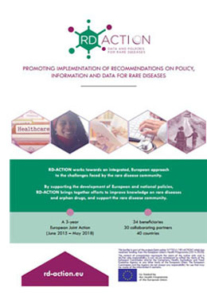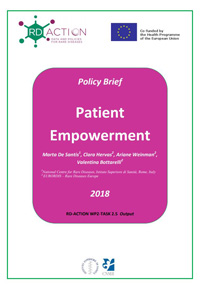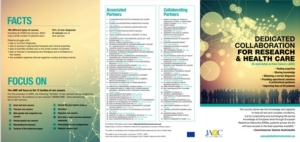What is an EU Joint Action?
A “Joint Action” is a collaborative action co-funded by the European Commission and Member States of the European Union on priority health issues, that deserve to be tackled at the European level. The objective is to elaborate joint proposals and recommendations aimed at providing a better support at European, national and local levels.
A Joint Action is essentially a large project divided into several sub-projects carried out by the different partners. EU Member States participate on a voluntarily basis and according to their specific interests in the topics covered.
EU Joint Actions on Rare Diseases and on Rare Cancers
-
RD-ACTION
The Joint Action on rare diseases, RD-ACTION, started on 1 June 2015 for a three year duration. It was the continuity of both the EUCERD Joint Action (March 2012 – November 2015) and the former Orphanet Joint Action.
Coordinator and partners
RD-ACTION was coordinated by INSERM/Orphanet Paris, France. It gathered 64 partners from 40 countries, including most EU Member States.
The partners involved represent ministries of health, public health institutions, Orphanet teams across Europe and beyond, researchers and patient organisations.
Achievements
The outcomes of RD-ACTION are the culmination of 10 years of stakeholders’ efforts for implementing the overall strategy set in the European Commission Communication on Rare Diseases: Europe’s Challenges (2008) and the Recommendations of the Council of the European Union on “an action in the field of rare diseases” (2009):
- providing information and data on rare diseases (expansion of Orphanet, the international portal for rare diseases and related services)
- improving the identification of rare diseases in health information systems (providing toolsets to integrate Orpha codes in healthcare systems)
- supporting the establishment and development of European Reference Networks
- publishing the State of the Art on Rare Diseases
- providing support to sustainable and resilient healthcare systems
- fostering National RD Plans and Strategies through the EUROPLAN National Conferences
EURORDIS’ involvement
- provided the rare disease patients’ perspective to shaping European Reference Networks
- organised the 8th European Conference on Rare Diseases and Orphan Products in 2016;
- facilitated the organisation of EUROPLAN National Conferences by National Alliances for rare diseases in Europe.
- coordinated the involvement of the National Alliances in the Resource on the State of the Art of Rare Disease Activities in Europe
- EURORDIS co-authored a policy brief on patient empowerment with the National Centre for Rare Diseases, Istituto Superiore di Sanità in Italy
-
JARC (EU Joint Action on Rare Cancers)
The JARC, started on 1 October 2016 for a three year duration. This is the first Joint Action tackling the issue of Rare Cancers. It is expanding on the work initiated in previous European projects, RARECARE and RARECARENet, which provided an operational definition of rare cancers, a list of rare cancers meeting this definition, strategies and networking mechanisms for disseminating quality information among all key players involved in Europe-wide surveillance on and treatment of rare cancers.
Coordinator and partners
JARC is coordinated by the Fondazione IRCCS Istituto Nazionale dei Tumori (Prof. Paolo Casali), Milan, Italy. It gathers 57 partners from 22 EU Member States and Norway and Switzerland.
The partners involved represent ministries of health, public health institutions, cancer control programmes, universities, population-based cancer registries, cancer institutes, other not-for-profit organisations and patient organisations.
The three partner patient organisations are the European Cancer Patient Coalition (ECPC), Childhood Cancer International (CCI) and EURORDIS. They are involved across all work packages of the JARC.
Objectives
All the partners of the JARC are engaged in working together to:
- prioritise rare cancers in the agenda of the EU and Member States, with a view to national cancer plans and quality of healthcare, harmonisation of clinical practice, innovation through promotion of clinical and translational research;
- develop innovative and shared solutions, mainly to be implemented through the European Reference Networks on rare cancers, in the areas of quality of care, research, education and state of the art definition on prevention, diagnosis and treatment of rare cancers.
EURORDIS’ involvement:
EURORDIS teams up with ECPC and CCI-Europe to represent the patients’ perspective in the work and future recommendations of the JARC.
EURORDIS’ specific mission is to:
- bring its expertise on the development of European Reference Networks involving elected representatives of European Patient Advocacy Groups (ePAGs) for each concerned ERN, namely EURACAN, PaedCan-ERN, EuroBloodNet, GENTURIS;
- make a link with ongoing work within the RD-ACTION, the Joint Action on Rare Diseases;
- identify synergies and areas of stronger collaboration between rare disease national plans and cancer national plans in EU Member States.
Visit the website for further information.
European Reference Networks (ERNs) on Rare Cancers
On 15 December 2016, the Board of EU member states on ERNs approved applications to forming ERNs. In the field of rare cancers, the following three ERNs have been approved:
- EURACAN – solid tumours in adults
- PaedCan-ERN – paediatric cancers
- EuroBloodNet – rare haematologic disorders including haematological malignancies in adults
The ERN GENTURIS (Genetic Tumour Risk Syndromes) covers some rare diseases which could give rise to cancers.



